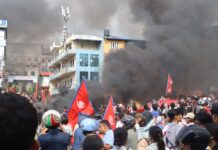Up to 30,000 people followed the call to protest made by the prominent, but also polarizing Sahra Wagenknecht of DIE LINKE (the Left Party) and “second-wave” bourgeois feminist, Alice Schwarzer, on February 25 in Berlin. In the days before, there had been a furore kicked up by the establishment media and parties against this rally, claiming that it was a “Querfront” [cross-front] of right-wingers and left-wingers.
SAV (ISA in Germany), Berlin
(This article was first published on 27 Feburary 2023)
The initiators of the call, under the name “Manifesto for Peace”, were directly or indirectly accused of doing Putin’s work for him. Leftists should reject this narrative, but at the same time lead the fight against the right and push for greater political clarity in the anti-war movement.
Even though right-wingers had mobilized to the rally and tried to abuse it for their own purposes, the mass of participants were “normal” people who are concerned that the war is escalating and think German arms deliveries are wrong. But even if fascists could not make their mark on the demonstration, the presence of right-wing populists, fascists and individual officials of the right-populist AfD (Alternative for Germany) at the rally remains a problem. However, it must also be stressed that the attempted embrace by this protest by the right was clearly opposed. From the stage and by demonstration stewards, it was made clear that Nazis are not welcome. Jürgen Elsässer from the far-right Compact magazine tried to make an offensive appearance with a squad of fascists and a banner. LINKE members opposed this with loud “Nazis out” chants and signs (Signs read, “There can be no peace with AfD & Co”) and finally successfully forced Elsässer out.
Responsibility of Wagenknecht
The initiators of the demo are responsible for the fact that this became necessary at all, with their unclear communication. Wagenknecht and [populist former member of SPD and LINKE] Oskar Lafontaine sent contradictory signals, sometimes saying that they did not want to see neo-Nazis there, then again that everyone who was “ wholeheartedly in favor of peace” should come. A clear dividing line against the right should have been drawn in advance. It should have been announced that all fascists who were recognized would be thrown out of the rally. This would have deterred them more.
Above all, it would have led to mobilizing leftists, who in the end stayed away because they feared ending up in a chaotic situation and being lumped together with the right. It was certainly a mistake that many leftists did not go and thus also refrained from bringing more Left content into the movement, but Wagenknecht and Lafontaine are responsible for this situation. They have made it easy for the bourgeois media to denigrate the whole cause — that of standing up against NATO’s involvement in the war, arms deliveries and the danger of escalation.
The LINKE party leadership has failed in the face of this challenge. It has in effect taken a position against going to the rally and demobilized its own members. In doing so, the party leadership has given in to pressure from the established parties, which defame any protest against NATO’s role and arms deliveries as right-wing and illegitimate. It has weakened the Left presence on the demo.
How to do it differently was shown by the comrades of the LINKE from different districts in Berlin (Mitte, Neukölln, Treptow-Köpenick and others), who produced their own posters and banners with slogans against the AfD and other right-wingers in the run-up to the demo.
What next?
In any case, this demonstration — as well as actions in other cities that were larger than expected — shows that concerns about the further escalation of the Ukraine war and criticism of arms deliveries are growing. The demonstration — for all its problems — has helped to move the public debate in a different direction, opposing the huge militaristic wave that is sweeping through almost all media.
But the political ambiguities of the Wagenknecht initiative also weigh heavily. Moreover, after a brief period of surprising objectivity immediately after the rally, new media gusts of defamation will blow in the face of the government’s critics. The LINKE seems paralyzed. Some of its members, who for good reasons have sharply criticized Wagenknecht in recent years, have become so entangled in inner-party disputes that they are failing to fight for an emerging anti-war movement. In building one, you will clash politically with Wagenknecht, but you have to be there first, in the streets, to lead that fight.
The potential for building a larger movement against the war being waged by Russia, but also against NATO militarism, has developed. One can and must argue about how such a movement can be built and gain power and authority. Wagenknecht and Schwarzer’s “Manifesto for Peace” is politically unclear, it deliberately excludes a Left perspective in order to be acceptable to bourgeois forces and even refrains from criticizing the rearmament of the Bundeswehr (German army) in order to include supporters of a more “independent” approach by German imperialism. It is an exaggeration to call this political approach a “cross-front” project, but the concept is nevertheless wrong and stands in the way of the movement’s ability to assert itself.
Against war and the causes of war
An anti-war movement must question the conditions from which war arises and which are exacerbated by war, that is, it must position itself against nationalism, social cuts, wage theft and inflation. Because not everyone is equally affected by war and its consequences. It is not the rich and powerful who sit in the trenches and die, but almost always ordinary workers. Likewise, it is mainly ordinary workers who suffer the consequences of war such as inflation, and rearmament at the expense of social welfare or climate protection.
The anti-war movement needs an internationalist class perspective. It has to point out that its allies are the workers in Russia, Ukraine, China, the USA, etc, who have to stand up against their belligerent rulers. A mere appeal to the rulers to get along and finally negotiate is not enough, because negotiations only take place when the domestic political pressure of the warring states is too great to continue the war. The workers have the power, through their position in the production process, to stop war production and logistics. An internationalist position would be to oppose all arms deliveries, not only of weapons from NATO to Ukraine, but also, for example, deliveries of drones from Iran to Russia. Such an internationalist class perspective would not only strengthen the movement politically, it would also automatically exclude the AfD and other right-wingers, with whom there really is no peace to be made




